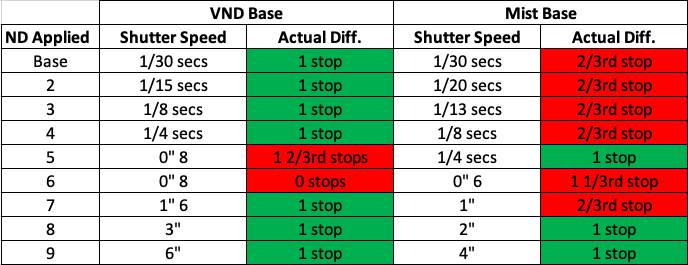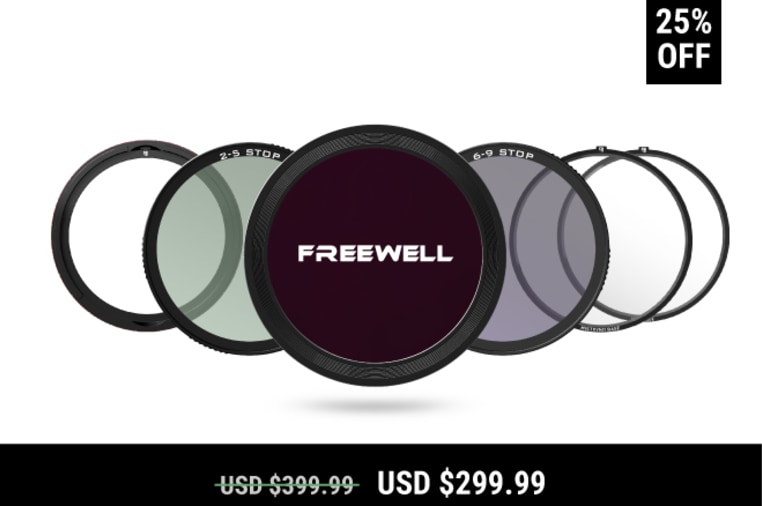July 21, 2021
Freewell Magnetic VND Camera Filter
This week we try out the world’s first versatile variable magnetic neutral density filter from Freewell

I’ve recently been sent a set of neutral density filters by Freewell that are currently selling through the crowd-funding website, IndieGoGo. The kit provided is the world’s first versatile variable magnetic neutral density filter. There are other variable ND filters available, but the innovation here is that they are incorporated into Freewell’s magnetic system, making it easier to apply and remove the filter in the field.

I’ve got to say that I have always been wary of variable ND filters. The problem they are all trying to solve is to reduce the amount of kit being carried by combining several stops of ND filter into one filter. However, in my experience, the results from variable systems have been, at best shaky! The systems can often result in an X-pattern appearing on your photos caused by the transition from one stop to the next being slightly ‘out’. As with all my reviews, I try to approach a product with a small amount of scepticism to see if it solves the issues seen in other similar products.
What’s in the box?
The packaging from the Freewell system is excellent, with an Apple-style feel to the box. Inside there are seven parts to the kit. Two variable ND filters go from 2 to 5 stops and the second from 6 to 9 stops. Two ‘base’ one-stop ND filters that provide a natural or mist effect. A ring to attach the filter to your lens. And finally, a lens cap and a convenient (and small) protective case to keep your filters safe and clean.
By flipping the two variable ND filters, there are also two circular polarisers with differing ND stops. It means that in total, the system has 20 different combinations.

How do they perform in the field?
I was pleasantly surprised by how well the system performed when out shooting in the landscape. I purposely went to a location that required a bit of clambering to get to and a small working area. The compactness of the system made it easy to carry. Once the ring is attached to the camera lens, the magnetic system worked very well, making it easy to attach and remove the different elements of the system.
My biggest concern will always be if the variable element to the filters would result in the infamous x-pattern appearing. I am pleased to report that even when I purposely took shots between the stop-markers, there was no evidence of any impact on the photos. It is definitely the first variable ND system where I have been pleased with the results—a big tick in the box for Freewell.
My only minor concern was that the markers didn’t always represent a full stop of light change, but I put this down to the changing light in the unusually sunny weather we currently have in Scotland. In any case, because the ND effect smoothly transitions between the markers, I could use the cameras light meter to turn the filter until it had the impact I wanted.
I am a stills photographer primarily, so I will often combine ND filters with graduated filters that fit a square filter system. There is an issue here in that the Freewell system doesn’t have a screw-fitting on the outside filters. The system is more tailored to videographers who want to reduce the light hitting the sensor to keep the shutter speed to 1/60th of a second, which is the optimal speed to prevent the rolling shutter effect.
How accurate are the stop markers?
As I had observed some slight differences in the performance of the filter effect against the actual shutter speeds, I wanted to have a more scientific test of how accurate the markers are on the Freewell system. I removed external influences by shooting a static object on a tripod in a studio-type environment with no natural light. In these circumstances, if an extra stop of the ND filter is dialled into the filter, then the shutter speed should halve. The table below shows the results of this test using both the Mist base and the standard one.

My initial observations in the field are confirmed with a more scientific test. Using the base filter, the 5 and 6 stop indicators are pretty inaccurate. A gap of 1 and 2/3rd stops moving from the 4 ND marker to 5, and switching to the 6-9 stop filter gives precisely the same result at five stops as it does at six stops. Using the Mist base ring, the results are even more variable, with only three of the ND markers resulting in an accurate reduction in the exposure.
The second test I wanted to check was how well the system reproduced colours. Quite often, filter systems can apply colour casts over the images. On the whole, this doesn’t appear to be the case with the Freewell system. Using an X-Rite Colour Checker, I measured how well different colours are captured as the ND filters are added. There is a small amount of variation, but this would be largely unnoticed to the untrained eye.
What’s the conclusion?
I am pleasantly surprised by the new Freewell VND camera filter system. It is a huge step forward in any variable ND filter I have seen before. The image quality using the filters is excellent with hardly any impact on colour reproduction. More important, is that Freewell appear to have overcome the X-pattern issue seen on pretty much every similar filter. The accuracy of the markers when using the different base filters is a little annoying, but because the filters are truly variable, it is easy to obtain the desired impact on exposure.

If I were mainly a videographer, then the Freewell Magnetic VND Filter system is a great buy. At the moment, you can get the entire system with 20 different settings for around £220 from the IndieGoGo page. As a stills landscape photographer, there is less benefit to the system. It would be great to have the capability to add graduated filters in front of the variable ND filter – maybe now that Freewell has cracked a useable variable filter, they could now develop a variable round graduated filter where the amount of ND and the place where the graduation occurs are choosable – there’s a challenge!
Give us your feedback
If you’ve got any questions or comments, leave them below. You can sign up for the Edinburgh Photography Workshop monthly newsletter, where you’ll get regular updates on exciting things happening in photography and some great tips. Sign up by clicking here.
About the author
As well as running Edinburgh Photography Workshop, Rich Dyson is a professional photographer. His photographs are regularly used in newspapers such as The Times, Guardian and Daily Telegraph. He also had two solo exhibitions and was featured in a members sponsored exhibition in the Scottish Parliament. You can see and buy his photography at richdysonphotography.com
